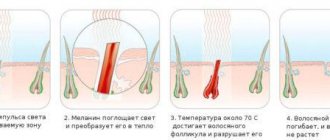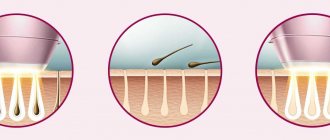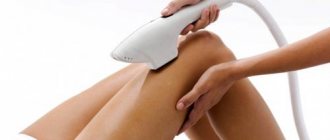Improved types of light hair removal
Depending on the device used, experts distinguish the following types of photoepilation:
1. Lhe. The intensity of the flashes here is relatively low, so the method does not require the use of cooling gel. The disadvantage of the technology is the relatively lengthy procedure.
2. Elos. The wavelength here is adjusted individually, this makes it possible to adjust the equipment without minimal risk of overheating the skin. A significant disadvantage of this type of hair removal is its absolute ineffectiveness for removing light hair.
3. Aft. It combines the effects of both light and laser energy, and the presence of a special filter limits the possibility of overheating. The technology is effective for removing light hairs and is completely safe even for dark skin.
How the device works
The photoepilator removes hairs in the growth stage using light pulses. Under the influence of a powerful beam, the pigment melanin, which is part of the hair, heats up, due to which the nutrition of the root is disrupted . The hair follicle, deprived of nutrition, is destroyed and the hair falls out after a while. After 5-10 photoepilation sessions at intervals of 2-3 weeks, abundant new hair growth may not be observed for several years.
The device can generate a flash of light waves with a length of 500-1200 nm. Depending on your skin type, hair color and length, the device is adjusted to the appropriate interval. Correct setting allows you to avoid burns and pigmentation of the skin. To ensure the safety of the hair removal procedure, the device is equipped with filtration and cooling systems.
Features of preparing and performing photoepilation
Before starting a course of procedures, it is recommended to visit a dermatologist, who must confirm the safety of using this technique for the client.
If the dermatologist has approved the procedure, preparation should be made, namely, reducing the length of the hairs to 1-2 mm. To do this, you should shave the relevant area one day before the procedure.
The procedure is carried out as follows:
The client sits comfortably, exposes the required part of the body and puts on special glasses with high protective properties.
To protect the client’s skin from radiation and prevent burns, the master applies a special gel. The tip of the photoepilation device is placed over the required area and passed over the specified area. Finally, the specialist removes the gel and treats the client’s skin with a soothing agent.
Main contraindications for photoepilation
Carrying out a cosmetic procedure, through which a change in the natural functioning of the body occurs, can be harmful for a certain circle of people. Determining the safety of a photoepilator on your own is not a pleasant life. Armed with a medical card with a medical history, you should consult a doctor. The connoisseur will be able to make a comprehensive analysis and give a medical opinion regarding the use of this procedure.
There are many contraindications to using a photoepilator: the presence of chronic diseases or skin characteristics can conceal negative health consequences. There are two groups of factors in photoepilation manipulation.
Absolute factors
As a medical contraindication, all kinds of inflammatory processes of the skin, rashes and formations on its surface are noted. Among the diseases for which hair removal using this method is not allowed are the following:
- varicose veins, even at the initial stage, with the appearance of a “vascular network”;
- scaly lichen;
- eczema;
- hypertension and other vascular diseases, especially dangerous for pacemaker users;
- infectious diseases;
- mental disorders;
- diseases of the thyroid chain;
- certain stages of diabetes;
- malignant formations on the skin.
Relative factors
Contraindications for photoepilator also include relative factors. This risk group includes cases that are not directly related to a woman’s health, but affect the possibility of using the device. Such prohibiting criteria could include:
- presence of tattoos in the desired areas of hair removal;
- “fresh” tan;
- individual impossibility;
- age limit - this fraud is not recommended for teenagers under 17 years of age;
- It is not advisable to use a photoepilator during pregnancy and lactation.
Yes, it is not allowed to carry out the photoepilation procedure if during this period the queen 2) -ka: the hostess is taking antibiotics and other medications that have photosensitizing properties.
If there were no above-mentioned disorders in the body, you can think about getting rid of unwanted sideburns once and for all. The only choice that remains to be made is to do photoepilation yourself or contact a cosmetologist. Everyone should evaluate their strengths and abilities individually, but in the absence of practice and skills, it is preferable, of course, to trust the masters of cosmetology centers.
Advantages of the photoepilation technique
The key advantage of photoepilation is the long-lasting effect - hairs do not grow much longer than after other removal methods. However, there are a number of other, no less important advantages:
- Highly effective removal of any type of hair, with the exception of very light ones.
- Thanks to the ability to adjust the intensity of the photoepilator flashes, it is possible to remove hair follicles at any depth.
- Minimal damage to the skin allows for safe procedure on any part of the body.
- Non-contact method of execution eliminates infection;
- No pain during the manipulation process.
- The speed of the procedure is up to 30 minutes;
- Stimulation of collagen formation provides the effect of rejuvenation and smoothing of the skin.
Differences between light and laser hair removal
It is quite difficult to distinguish laser hair removal from light hair removal, since in both methods hair removal is carried out using light waves. However, there are many differences, including:
- The photoepilator emits light with the widest spectrum - 560-1200 nm. This means that the operating principle of the device provides for a pair of lasers that can remove dark hair from any skin tone.
- The photoepilator does not remove all unwanted vegetation in a given area, due to the peculiarities of the laser system. Therefore, if we compare the technique with laser hair removal, even the minimum number of sessions required to remove body hair doubles.
- Since the operation of a photoepilator involves many elements emitting light, the range of action of the device increases significantly. And the duration of the session is reduced by 3 times compared to laser hair removal.
The effectiveness of a photoepilator at home
The effectiveness of photoepilation directly depends on the amount of melanin in the hair structure. This means that a positive result is most likely on dark-colored hair. Therefore, the effect of a photoepilator on gray hair is ineffective.
By adjusting the range of light waves and the number of procedures, you can achieve a positive result when removing light-colored hair. If on average 4-6 photoepilation sessions are needed to remove dark hair, then fair-haired people will need twice as many sessions for a positive effect.
Important! The device is universal, equally effective in combating hair growth on the arms, legs, back, bikini area, face and armpits.
Thermal effects on the skin cause the following effects:
- temporary redness and peeling of the treated area of the skin;
- failure of pigmentation, which goes away on its own after some time;
- dilation of blood vessels;
- bruising and swelling are possible;
- pain in people with a low sensitivity threshold.
The listed elements of discomfort do not cause significant harm to health. The benefit of photoepilation is the removal of unwanted hair for a long period of time.
Photoepilation: contraindications and undesirable consequences
There are contraindications for light hair removal, as well as for other methods of removing unwanted hairs:
- Adolescence;
- Pregnancy;
- Diabetes;
- Pathologies of organs providing blood circulation;
- Varicose veins;
- Any disease or damage to the skin;
- Presence of birthmarks in the treatment area;
- Porphyrin disease, sunlight intolerance;
- Heavy tan;
- Taking steroid drugs.
Before visiting the salon, experts recommend making sure that there are no any of the above problems. It is also extremely important to obtain the approval of a cosmetologist. After all, if you do not undergo diagnostics before photoepilation, the consequences in this case can be the most unpleasant. The main undesirable consequences of light hair removal in such cases include:
- Formation of age spots and burns;
- Manifestations of allergies;
- Severe swelling;
- Excessive expansion of capillaries and blood vessels;
- Significant irritation, redness, peeling, itching.
Setting up the photoepilator and performing the procedure
The instructions for photoepilators usually contain a color scale, which can be used to determine the color type of skin and hair and set the appropriate operating mode. In more expensive models, there is an automated detection system, and the device will adjust automatically, you just need to bring it to your skin and hair.
Comparative table of hair and skin shades in the instructions for the photoepilator
During processing, the photoepilation device emits sound signals, signaling the beginning and end of light exposure. There should be no pain during the process, otherwise we can talk about incorrect settings of the device.
The absence of any sensations is also not a good sign; in this case, we are talking about a weak impact and ineffectiveness of the session. During photoepilation, a slight tingling sensation and warmth are considered normal.
For the first time, photoepilation is recommended to be performed on the skin of the legs. The skin on the face, bikini area, and armpits is more delicate.
To get the best result in the armpit area, the skin needs to be as even as possible. If there are birthmarks in the treatment area, you can protect them using any universal cream or office corrector.
Check out our review of the best photoepilators for hair removal at home.
Photoepilation at home
Is it possible to do photoepilation at home? This is a question that interests many women.
To answer this question, many factors must be taken into account. Here everything depends not on the high cost of the photoepilator, but also on its settings. In this case, it is important to choose the radiation interval and, of course, the power at which the hair follicles will be destroyed and the skin will not be damaged. There is no need to be afraid of photoepilation at home, since the developers of photoepilators foresaw the danger of such consequences and made their maximum power completely safe for the user’s skin. Therefore, having carefully read the rules for using the photoepilation device at home, it will be quite simple to set it up correctly.
Correct photoepilation
Armed with the necessary information and having studied the instructions for the photoepilator, the procedure can be carried out at home. Knowledge will also help you evaluate the professionalism of a cosmetologist if you decide to visit a beauty salon to carry out this manipulation.
So, to remove hair with a light device, you must follow the following rules.
- Prepare the skin for the procedure: do not sunbathe 14 days before and after the procedure, take aggressive medications, ensure that there are no abrasions or irritations on the desired area of the skin.
- Leave the length of the hair fiber no longer than 2mm. For proper hair removal, you can shave the area with a regular razor 2-4 days before the procedure.
- Adjust the photoepilator according to your skin color. The lighter the skin, the higher the power needed. Manufacturers complete inexpensive device models with a color table, with the help of which it is easy to select device settings according to the color type of skin and hair. Expensive models are equipped with a sensor system, thanks to which the device automatically selects the optimal mode.
- Mark the area affected by the device with a pencil and apply a special cooling gel. The light pulse has a negative effect on the retina of the eye, so sunglasses will be needed.
- It is necessary to bring the device closer to the skin at such a distance that the light beam turns on, and then treat the next area. It is necessary to move the beam in such a way that the light spot does not cover the already treated area.
- The device signals the beginning and end of light exposure with a sound signal. The device is considered effective if a slight tingling or warmth is felt during the procedure. Severe pain, as well as the absence of any effects, is a sign of incorrect settings of the photoepilator.
- After completing the procedure, lubricate the area of skin treated with light with panthenol.
It should be noted that after treating the hair with a photoepilator, the color of the hairs will first begin to change, and after 2 weeks they will fall out . The procedure can be repeated no earlier than after 1 month. The destruction of all bulbs in the treated area will occur in several procedures. Depending on the fiber structure, up to 10 sessions may be needed.
Considering that the device will be in demand again after use, it is important to clean it promptly and thoroughly with a special spray.
Post-procedure care
A completely normal reaction of the skin to such an external irritant as UV rays is the appearance of slight redness, swelling, and peeling in the area of hair removal procedures. Moreover, if you follow some recommendations, the skin will recover within a week.
After the hair removal procedure, it is recommended to apply a special cream that will not only soothe the skin, but also moisturize it.
For one day after photoepilation, it is highly undesirable to take a bath, take a cold or too warm shower, wear tight-fitting clothes in contact with the treated area, or use any cosmetics other than moisturizer.
From the first to the last session, it is prohibited to go to the solarium, sunbathe on the beach, or remove hair by any other method other than shaving. Moreover, for two weeks, the use of sunscreen is highly recommended if the skin is not covered with clothing.
If severe redness or burning is observed after the manipulation, the use of any anti-burn medication is recommended.
Photoepilation: how many sessions are needed?
On average, the number of photoepilation sessions required to ensure a lasting effect is 5 or 6. However, the procedure must be carried out strictly after a certain period of time, when unwanted hairs are at a certain stage of growth.
Therefore, when answering the question of how often photoepilation should be done during the course, it is advisable to consider proven statistics: it is advisable to repeat the procedure every few weeks. This will destroy 30% of unwanted hair that is ready for removal.
We also must not forget that a second course of such hair removal will need to be carried out after seven to eight months, otherwise the hair on the body will appear again.
How does photoepilation work?
Photoepilation as a cosmetic method involves removing hair using controlled light pulses. The mechanism of action is reminiscent of a laser technique - the hair follicle is destroyed from the inside, after which hair never appears in this place again. It works like this: the device delivers a light pulse, which is absorbed by melanin in the hair. As absorption accumulates, it creates a powerful thermal effect that affects the follicle’s feeding channels, blocking them. The hair does not receive nutrition and is gradually destroyed. This aspect is where one of the peculiarities of the procedure lies - the destruction of the hair occurs not only at the moment of exposure to light, but continues after, which gradually leads to a stop in its growth and loss.
Almost any woman can resort to photoepilation - the method is effective on hairs of any color, texture, growing on any skin type and on any area, including the bikini area, armpits and face. During the hair removal process, the integrity of the skin is maintained, which is also important. The process does not bring any unpleasant sensations, much less pain, which also sets it apart from other procedures. Another advantage is short sessions, it will only take 5-20 minutes depending on the area of treatment. In addition to the long-term removal of “vegetation” on the body, photoepilation also has a number of other positive effects:
- reducing the visibility of spider veins;
- combating age-related skin changes, smoothing out small wrinkles;
- dark spots.
Thus, photoepilation is considered as a general method for skin rejuvenation, the main purpose of which is to remove unwanted hair.
Efficiency of the procedure
The high efficiency of the photoepilation technique has been proven by many years of experience in its use. People who have tried it note the absence of side effects, and after 4-5 procedures, the majority report an almost complete disappearance of the growth of unwanted hairs on the body.
It is important to note that during the first procedure, the flash affects only the roots; the hair shafts themselves are not destroyed. That is why, after two weeks, the hairs fall out on their own.
After three or four procedures, the vegetation on the human body is halved, grows more slowly, and becomes less dense.
Before and after photos, video
The degree of effectiveness of the method can be judged by looking at many photos before and after the procedure.
Information about photoepilation of the upper lip, neck, armpits or any other area can be found by watching the suggested videos.
There are many ways to get rid of unnecessary hair on the body. However, one of the most effective and safest techniques is photoepilation.
Has light hair removal been proven to be harmful?
Proponents of this type of hair removal claim that the action of targeted light flashes is beneficial for mature skin. Under their influence, the process of rejuvenation of the epidermis is launched, the production of collagen and elastin, which promote regeneration, is accelerated. But before you run to the salon to combat annoying hair, you need to know for sure whether photoepilation is harmful, and are there any contraindications to the procedure? And, by the way, there are a lot of them:
- varicose veins (expansion of veins);
- the presence of wounds, inflammations, abrasions and other damage to the area of skin being treated;
- fresh tan (including in a solarium);
- a short period of time after intensive hair removal (sugaring, waxing, laser hair removal);
- diabetes;
- skin diseases (eczema, psoriasis, dermatitis);
- infectious diseases;
- oncology (at any stage);
- heart and blood pressure problems;
- the presence of a pacemaker, insulin pump or other electronic devices in the body;
- pregnancy (at any stage) and breastfeeding;
- taking certain medications and steroids;
- presence of a tattoo in the place where hair removal is planned;
- allergies (including to sunlight);
- colds (especially fever).
Based on the foregoing, it becomes clear that the first thing you need to do is consult with your doctor. However, even in completely healthy people (and men also sometimes resort to this procedure), problems may arise after the first or subsequent photoepilation sessions. Namely:
- swelling;
- redness and peeling of the skin;
- change in natural skin pigmentation (returns to normal over time);
- vasodilation (appearance of spider veins);
- irritation (especially after epilation of the bikini area).
To prevent such troubles from occurring, it is important to adhere to the basic rules and, most importantly, visit a dermatologist before visiting the salon. A qualified specialist will assess the condition of the skin and give useful advice on caring for the epidermis before and after the procedure.
Photoepilation, whose harm to healthy skin is minimal, is an excellent solution for those who dream of smooth skin without excess hair, but do not want to endure pain.











